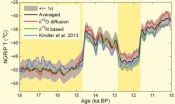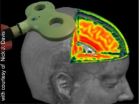(Press-News.org) Munich, Germany: The timing of food intake in the early phase of TB treatment could have a negative impact on the effectiveness of TB treatment.
A new study, presented at the European Respiratory Society (ERS) International Congress in Munich today (07 September 2014), suggests that eating food just before taking a TB drug could reduce the effectiveness of the medicine.
Researchers conducted a small study looking at 20 patients who were about to begin treatment for TB for the first time. They were given the usual course of TB drugs, including isoniazid, rifampicin, pyrazinamide and ethambutol. The drugs were administered by injection on day one and given orally on day two and three, either while fasting or with a high carbohydrate meal.
Blood samples were taken from each participant and an analytical chemistry technique, called liquid chromatography tandem-mass spectrometry, was used to separate the sample and give information about the chemicals present. This technique allows the researchers to assess concentration levels of the drug and fraction of the unchanged drug that reaches the circulation.
Blood samples were taken from the same individual and in the same environment while changing the food intake. The results showed that when the drugs were given with a high-carbohydrate meal, there was a lower concentration of isoniazid, rifampicin, and pyrazinamide in the blood compared with when they were given in a fasting state. This suggests that eating a high carbohydrate meal, before taking the drugs can make the drugs less effective.
Dr Antonia Morita Iswari, lead author from the Universitas Gadjah Mada in Indonesia and currently completing her PhD program at the University of Groningen, said: "As the research was conducted in the same people and the same environment, the only variable was the meals and we therefore know that food can have an impact on the concentration of the drugs in the blood. The findings may have significant implications for clinical practice as we must ensure that patients are taking the drugs in the correct way to be as effective as possible."
INFORMATION: END
Timing of food intake could impact the effectiveness of TB treatment
2014-09-07
ELSE PRESS RELEASES FROM THIS DATE:
Patients call for health professionals to discuss care needs in life-threatening illnesses
2014-09-07
Munich, Germany: Patients with COPD would like healthcare professionals to discuss palliative care needs in more detail, according to a new study.
Palliative care refers to care that is focused on making a person comfortable and relieving symptoms, rather than treating a condition. It is often connected with end-of-life care; although it can refer to any stage of care for any life-threatening condition.
The research, presented at the European Respiratory Society (ERS) International Congress in Munich today (7 September 2014), investigated the preferences of patients ...
Mandatory policy boosts flu vaccination rates among health care workers
2014-09-07
DETROIT – Hospitals can greatly improve their flu vaccination rate among health care workers by using a mandatory employee vaccination policy, according to a Henry Ford Health System study.
Citing its own data, Henry Ford researchers say the health system achieved employee vaccination rates of 99 percent in the first two years of its mandatory policy, in which annual vaccination compliance is a condition of employment.
Nationally, 63 percent of health care workers were immunized against the flu in the past two years, according to the Centers for Disease Control and ...
New single-dose influenza drug appears safe and effective
2014-09-06
An analysis of phase 2 and phase 3 clinical trials shows that a single injected dose of the neuraminidase inhibitor (NAI) peramivir is safe and effective at alleviating influenza symptoms, including fever and viral shedding, when administered within 48 hours of the onset of symptoms. Researchers report their findings today at the 54th Interscience Conference on Antimicrobial Agents and Chemotherapy (ICAAC), an infectious diseases meeting of the American Society for Microbiology (ASM).
"Based on clinical data, peramivir is the first neuraminidase inhibitor (NAI) that ...
Antibiotic stewardship programs reduce costs, improve outcomes
2014-09-06
Antibiotic stewardship programs, which promote the appropriate use of antibiotics in hospitals and other healthcare centers, not only lead to reduction in antibiotic use with reduced adverse events, but also lead to significant savings. In the case of one New York hospital, more than $600,000 was saved annually, according to research presented today at the 54th Interscience Conference on Antimicrobial Agents and Chemotherapy (ICAAC), an infectious diseases meeting of the American Society for Microbiology (ASM).
"This work emphasizes the rational approach to treating patients: ...
New study reveals strong link between higher levels of pollution and lung health of European citizen
2014-09-06
New data has identified a clear link between higher levels of exposure to air pollution and deteriorating lung health in adult European citizens. This study confirms previous findings that children growing up in areas with higher levels of pollution will have lower levels of lung function and a higher risk of developing symptoms such as cough and bronchitis symptoms. Additionally, the new study identified that people suffering from obesity are particularly vulnerable to the negative effects of air pollution, possibly due to an increased risk of lung inflammation.
Senior ...
Penn team finds ovarian cancer oncogene in 'junk DNA'
2014-09-06
PHILADELPHIA - Over the years researchers have made tremendous strides in the understanding and treatment of cancer by searching genomes for links between genetic alterations and disease.
Most of those studies have focused on the portion of the human genome that encodes protein – a fraction that accounts for just 2 percent of human DNA overall. Yet the vast majority of genomic alterations associated with cancer lie outside protein-coding genes, in what traditionally has been derided as "junk DNA." Researchers today know that "junk DNA" is anything but – much of it is ...
Past temperature in Greenland adjusted
2014-09-05
One of the common perceptions about the climate is that the amount of carbon dioxide in the atmosphere, solar radiation and temperature follow each other – the more solar radiation and the more carbon dioxide, the hotter the temperature. This correlation is also seen in the Greenland ice cores that are drilled through the approximately three kilometer thick ice sheet. But during a period of several thousand years up until the last ice age ended approximately 12,000 years ago, this pattern did not fit and this was a mystery to researchers. Now researchers from the Niels ...
WHO-commissioned report on e-cigarettes misleading, say experts
2014-09-05
World leading tobacco experts argue that a recently published World Health Organization (WHO)-commissioned review of evidence on e-cigarettes contains important errors, misinterpretations and misrepresentations putting policy-makers and the public in danger of foregoing the potential public health benefits of e-cigarettes.
The authors, writing today in the journal Addiction, analyse the WHO-commissioned Background Paper on E-cigarettes, which looks to have been influential in the recently published WHO report calling for greater regulation of e-cigarettes.
Professor ...
Visualizing plastic changes to the brain
2014-09-05
Tinnitus, migraine, epilepsy, depression, schizophrenia, Alzheimer's: all these are examples of diseases with neurological causes, the treatment and study of which is more and more frequently being carried out by means of magnetic stimulation of the brain. However, the method's precise mechanisms of action have not, as yet, been fully understood. The work group headed by PD Dr Dirk Jancke from the Institut für Neuroinformatik was the first to succeed in illustrating the neuronal effects of this treatment method with high-res images.
Painless Therapy
Transcranial magnetic ...
Harvard and Cornell researchers develop untethered, autonomous soft robot
2014-09-05
New Rochelle, NY, September 4, 2014--Imagine a non-rigid, shape-changing robot that walks on four "legs," can operate without the constraints of a tether, and can function in a snowstorm, move through puddles of water, and even withstand limited exposure to flames. Harvard advanced materials chemist George Whitesides, PhD and colleagues describe the mobile, autonomous robot they have created in Soft Robotics, a peer-reviewed journal from Mary Ann Liebert, Inc., publishers. The article is available on the Soft Robotics website.
In "A Resilient, Untethered Soft Robot," ...




